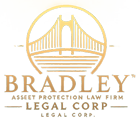Understanding Legal and Practical Authority in Real Estate Asset Protection
A common and critical question I hear is:
“Brian, I heard you explain why you consider real estate assets to be different from cash or liquid assets. If a local judge can order those properties sold regardless of how they are titled, what protection does an LLC or LP really provide?”
This question highlights a fundamental issue in real estate asset protection planning: the difference between legal authority (the laws that should protect your assets) and practical authority (how judges actually enforce or bypass those laws).
Real estate is fundamentally different from liquid assets like cash or stocks because:
✔ Real estate cannot be moved—it remains under the jurisdiction of local courts no matter where you structure ownership.
✔ What matters is net equity and cash flow, not fair market value (FMV).
✔ Asset protection is about ensuring you can legally move the equity post-lawsuit—not just before.
The ultimate goal is to build a multi-layered system that separates risk from assets, protects equity, and allows flexibility for legal post-lawsuit asset movement.
Concept #1: Equity & Cash Flow Are What Matter (Not Fair Market Value)
Many people think of real estate protection in terms of how much their properties are worth, but this is a mistake. The real concerns are:
• Net Equity – The actual value left after subtracting debt.
• Cash Flow – Whether the property is generating income or bleeding money.
Example: The Illusion of Gross Value
A real estate investor might own a $25 million portfolio—which sounds impressive. But if that portfolio has $20 million in debt, the net equity is only $5 million.
Now, what if the properties don’t generate enough income to cover mortgage payments?
Let’s say the investor has a negative cash flow of $100,000 per month ($1.2 million per year). If the properties aren’t appreciating fast enough, the investor is actually losing money.
Why This Matters for Asset Protection
Creditors don’t care about gross value—they want to go after net equity and cash flow.
✔ If you have little or no net equity, there’s nothing for creditors to seize.
✔ If a property has negative cash flow, creditors may not want it at all.
This means debt can be a legitimate tool for asset protection—but only as part of a broader system.
Concept #2: Separate the Risk from the Assets
A fundamental principle of real estate asset protection is keeping risk and valuable assets separate.
Think of this like having a “designated driver” at a party—someone who takes the risk while the valuable passengers remain safe.
Real-World Example: The Medical Doctor’s Office
A doctor owns a $1 million office building and also operates a medical practice that sees dozens of patients daily.
• The practice is high-risk (patients, employees, malpractice exposure).
• The real estate is valuable but doesn’t create liability.
Mistake: If the medical practice owns the office building, any lawsuit against the practice exposes the real estate.
Solution: The office should be placed into its own LLC, separate from the medical practice.
✔ If the practice is sued, the real estate remains safe.
✔ The doctor can still rent the building to the practice, creating tax benefits.
This separation of risk and assets applies to all real estate investors, ensuring that high-value properties aren’t exposed to the liability of operations.
Concept #3: Create Layers of Protection
If you’ve ever lived in a cold climate, you know that layers keep you warm while allowing flexibility. Asset protection works the same way.
Layer 1: Individual LLCs for Each Property Group
Each group of properties should be held in a separate LLC to limit inside liability (i.e., lawsuits related to the property itself, like tenant injuries).
✔ If a tenant sues over a slip-and-fall, the lawsuit is contained to that LLC.
✔ Other properties in separate LLCs are protected.
Layer 2: Real Estate Holding Company
A real estate holding company (like an Asset Management Limited Partnership (AMLP) or Master LLC) should own all the individual property LLCs.
✔ Consolidates tax reporting into one return.
✔ Eliminates the risk of a single-member LLC (the holding company is multi-member).
✔ Improves estate planning options.
✔ Can be located in a strong asset protection jurisdiction (like Wyoming or Arizona).
Layer 3: Offshore Trust – The Final “Waterproof” Layer
The strongest layer is integrating The Bridge Trust®, an offshore asset protection trust, with the holding company.
✔ U.S. judges have no authority over offshore trusts.
✔ If a lawsuit escalates, the trust can legally disconnect assets from U.S. court jurisdiction.
✔ Creates a legal “firewall” that prevents creditors from seizing real estate equity.
Full Step-by-Step System Integration
Step 1: Determine Your NET Equity
(Not FMV!) – Identify your true net worth in real estate.
Step 2: Separate High-Risk and Low-Risk Assets
Place high-value properties in separate LLCs away from high-liability operations.
Step 3: Group Properties into Risk Pools
No single LLC should hold too much equity (recommendation: $500,000 max per LLC).
Step 4: Form Individual LLCs for Each Property Group
(Three properties worth $1.5M? Create 3 LLCs.)
Step 5: Establish a Multi-Member Holding Company
Use an AMLP or Master LLC as the single owner of your LLCs.
Step 6: Transfer LLC Ownership into the Holding Company
✔ Eliminates separate tax returns for each LLC.
✔ Consolidates accounting and reporting.
Step 7: Add The Bridge Trust®
The offshore trust serves as the “escape hatch” if a major lawsuit threatens your portfolio.
Equity Stripping: Why It’s the Last Step (and Must Be Done Right)
After the entire asset protection system is in place, the final step—only if needed—is to make real estate equity less attractive to creditors.
✔ Debt reduces equity, making properties harder for creditors to seize.
✔ However, simply placing a “friendly lien” does NOT work—it’s legally fraudulent unless for fair market value.
Read this article to see the case law on why fraudulent liens fail. https://btblegal.com/blog-articles/f/understanding-equity-stripping-aka-friendly-liens-do-they-work
If equity stripping is used, it must:
✔ Be structured with a legitimate third-party lender.
✔ Have proper documentation and fair value exchange.
✔ Comply with legal standards to avoid fraudulent transfer claims.
We do not prefer equity stripping, but it remains an option if executed properly.
Final Thoughts: The Full System Is What Matters
✔ LLCs, LPs, and offshore trusts must be integrated correctly—no single layer is enough.
✔ The goal is to separate risk from valuable assets.
✔ Net equity and cash flow—not FMV—determine your real estate protection.
✔ The real key is legally moving equity post-lawsuit, not before.
If you own rental properties, commercial real estate, or high-value investments, let’s build your full protection system. Schedule a consultation today.
For a legal strategy consultation call (888) 773-9399 to speak with an asset protection lawyer.
By: Brian T. Bradley, Esq.




